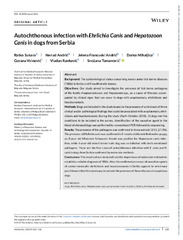Приказ основних података о документу
Autochthonous infection with Ehrlichia Canis and Hepatozoon Canis in dogs from Serbia
| dc.creator | Sukara, Ratko | |
| dc.creator | Andrić, Nenad | |
| dc.creator | Francuski Andrić, Jelena | |
| dc.creator | Mihaljica, Darko | |
| dc.creator | Veinović, Gorana | |
| dc.creator | Ranković, Vladan | |
| dc.creator | Tomanović, Snežana | |
| dc.date.accessioned | 2023-01-31T11:18:24Z | |
| dc.date.available | 2023-01-31T11:18:24Z | |
| dc.date.issued | 2023 | |
| dc.identifier.issn | 2053-1095 | |
| dc.identifier.uri | http://rimi.imi.bg.ac.rs/handle/123456789/1270 | |
| dc.description.abstract | Abstract Background The epidemiological status concerning many canine tick-borne diseases (TBDs) in Serbia is still insufficiently known. Objectives Our study aimed to investigate the presence of tick-borne pathogens of the family Anaplasmataceae and Hepatozoon spp., as a cause of illnesses accompanied by clinical signs that can occur in dogs with anaplasmosis, ehrlichiosis and hepatozoonosis. Methods Dogs are included in the study based on the presence of a minimum of three clinical and/or pathological findings that could be associated with anaplasmosis, ehrlichiosis and hepatozoonosis. During the study (April–October 2018), 11 dogs met the conditions to be included in the survey. Identification of the causative agent in the blood of diseased dogs was performed by conventional PCR followed by sequencing. Results The presence of the pathogens was confirmed in three animals (3/11, 27.3%). The presence of Ehrlichia canis was confirmed in 3-month-old female Rottweiler puppy, an 8-year old Miniature Schnauzer female was positive for Hepatozoon canis infection, while 4-year-old mixed breed male dog was co-infected with both mentioned pathogens. These are the first cases of autochthonous infection with E. canis and H. canis in dogs from Serbia confirmed by molecular methods. Conclusions The results of our study indicate the importance of molecular methods to establish a reliable diagnosis of TBDs. Also, the confirmed presence of causative agents of canine monocytic ehrlichiosis and hepatozoonosis in Serbia appeals to veterinary practitioners that it is necessary to exclude the presence of those diseases in suspicious dogs. | |
| dc.publisher | Wiley-Blackwell | |
| dc.relation | info:eu-repo/grantAgreement/MESTD/inst-2020/200015/RS// | |
| dc.relation | info:eu-repo/grantAgreement/MESTD/inst-2020/200143/RS// | |
| dc.rights | openAccess | |
| dc.rights.uri | https://creativecommons.org/licenses/by/4.0/ | |
| dc.source | Veterinary Medicine and Science | |
| dc.subject | dogs | |
| dc.subject | Ehrlichia canis | |
| dc.subject | Hepatozoon canis | |
| dc.subject | polymerase chain reaction | |
| dc.subject | Serbia | |
| dc.subject | tick-borne diseases | |
| dc.title | Autochthonous infection with Ehrlichia Canis and Hepatozoon Canis in dogs from Serbia | |
| dc.type | article | |
| dc.rights.license | BY | |
| dc.citation.epage | 118 | |
| dc.citation.issue | 1 | |
| dc.citation.spage | 111 | |
| dc.citation.volume | 9 | |
| dc.identifier.doi | 10.1002/vms3.1061 | |
| dc.identifier.fulltext | http://rimi.imi.bg.ac.rs/bitstream/id/2869/Autochthonous_infection_with_Ehrlichia_Canis_and_Hepatozoon_Canis_pub_2022.pdf | |
| dc.type.version | publishedVersion |

